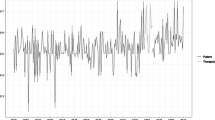Abstract
We describe the development of a new system for categorizing thought disorder. In the development phase (Study 1), we examined the degree to which speech samples and definitions of thought disorder subtypes taken from: (1) the Scale for the Assessment of Thought, Language, and Communication (TLC); (2) the Though Disorder Index (TDI); and (3) the Assessment of Bizarre-Idiosyncratic Thinking (BIT), reflected disturbances in form versus disturbances in content. Ratings were provided by naive judges, experienced clinicians, and linguistic experts. The results contributed to the development of a new system dividing thought disorder into disturbances in (1) fluency, (2) discourse coherence, (3) content, and (4) social convention. In the validation phase (Study 2), 21 schizophrenic and 19 manic subjects were interviewed, interpreted proverbs, and responded to Rorschach cards. Subjects' speech was rated using the TLC, TDI, and BIT. We also measured hallucinations, delusions, and digit span performance. The results of Study 2 provided evidence supporting the validity of our new categorization system.
Similar content being viewed by others
References
Andreasen, N. C. (1979a). Thought, language, and communication disorders. I. Clinical assessment, definition of terms, and evaluation of their reliability.Archives of General Psychiatry, 36, 1315–1321.
Andreasen, N. C. (1979b). Though, language, and communication disorders. II. Diagnostic significance.Archives of General Psychiatry, 36, 1325–1330.
Andreasen, N. C. (1982). Should the term “thought disorder” be revised?Comprehensive Psychiatry, 23, 291–299.
Andreasen, N. C. (1986). The scale for assessment of thought, language and communication (TLC).Schizophrenia Bulletin, 12, 473–482.
Berenbaum, H. (1991). Distinguishing between content and form of speech.Archives of General Psychiatry, 48, 280.
Berenbaum, H., & Oltmanns, T. F. (1983).Instruction manual for the assessment of formal thought disorder. Unpublished manuscript.
Berenbaum, H., Oltmanns, T. F., & Gottesman, I. I. (1985). Formal thought disorder in schizophrenics and their twins.Journal of Abnormal Psychology, 94, 3–16.
Chaika, E. (1990).Understanding psychotic speech: Beyond Freud and Chomsky. Springfield, IL: Charles C Thomas.
Cohen, J. D., & Servan-Schreiber, D. (1992). A parallel distributed processing approach to biology and behavior in schizophrenia.Psychological Review, 99, 45–77.
Cutting, J., & Murphy, D. (1988). Schizophrenic thought disorder: A psychological and organic interpretation.British Journal of Psychiatry, 152, 310–319.
Fish, F. (1964).An outline of psychiatry for students and practitioners. Bristol: John Wright & Sons.
Gorham, D. R. (1956). A proverbs test for clinical and experimental use.Psychological Reports, 1, 1–12.
Grebb, J. A., & Cancro, R. (1989). Schizophrenia: Clinical features. In H. I. Kaplan & B. J. Sadock (Eds.),Comprehensive textbook of psychiatry/Vol. 1, 5th ed., Baltimore, MD: Williams and Wilkins.
Harvey, P. D., Earle-Boyer, E. A., & Levinson, J. C. (1988). Cognitive deficits and thought disorder: A retest study.Schizophrenia Bulletin, 14, 57–65.
Harvey, P. D., Docherty, N. M., Serper, M. R., & Rasmussen, M. (1990). Cognitive deficits and thought disorder. II. An 8-month follow-up study.Schizophrenia Bulletin, 16, 147–156.
Harrow, M., Lanin-Kettering, I., & Miller, J. G. (1989). Impaired perspective and thought pathology in schizophrenic and psychotic disorders.Schizophrenia Bulletin, 15, 605–623.
Hoffman, R. E. (1986). Verbal hallucinations and language production processes in schizophrenia.Behavioral and Brain Sciences, 9, 503–548.
Hurt, S. W., Holzman, P. S., & Davis, J. M. (1983). Thought disorder: The measurement of its changes.Archives of General Psychiatry, 40, 1281–1285.
Johnston, M. H., & Holzman, P. S. (1979).Assessing schizophrenic thinking. San Francisco, CA: Jossey-Bass.
Lanin-Kettering, I., & Harrow, M. (1985). The thought behind the words: A view of schizophrenic speech and thinking disorders.Schizophrenia Bulletin, 11, 1–7.
Levelt, W. J. M. (1989).Speaking: From intention to articulation. Cambridge: MIT Press.
Lukoff, D., Nuechterlein, K. H., & Ventura, J. (1986). Manual for expanded Brief Psychiatric Ratings Scale (BPRS).Schizophrenia Bulletin, 12, 594–602.
Maher, B. (1972). The language of schizophrenia: A review and interpretation.British Journal of Psychiatry, 120, 4–17.
Marengo, J., Harrow, M., Lanin-Kettering, I., & Wilson, A. A. (1985). A manual for assessing aspects of bizarre-idiosyncratic thinking. In M. Harrow & D. Quinlan (Eds.),Disordered thinking and schizophrenic psychopathology (pp. 394–411). New York: Gardner Press.
Meng, X. L., Rosenthal, R., & Rubin, D. B. (1992). Comparing correlated correlation coefficients.Psychological Bulletin, 111 172–175.
Oltmanns, T. F., & Neale, J. M. (1975). Schizophrenic performance when distractors are present: Attentional deficit or differential task difficulty.Journal of Abnormal Psychology, 84, 205–209.
Pandurangi, A. K., Sax, K. W., Pelonero, A. L., & Goldberg, S. C. (1994). Sustained attention and positive formal thought disorder in schizophrenia.Schizophrenia Research, 13, 109–116.
Rochester, S. R., & Martin, J. (1979).Crazy talk: A study of the discourse of schizophrenic speakers. New York: Plenum.
Schilder, P. (1951). On the development of thoughts. In D. Rapaport (Ed., Trans.),Organization and pathology of thought (pp. 497–518). New York: Columbia University Press.
Shenton, M. E., Holzman, P. S., Solovay, M. R., & Coleman, M. (1991). Distinguishing between content and form of speech: Reply to Berenbaum.Archives of General Psychiatry, 48, 281.
Shenton, M. E., Solovay, M. R., Holzman, P. S., Coleman, M., & Gale, H. J. (1989). Thought disorder in the relatives of psychotic patients.Archives of General Psychiatry, 46, 897–901.
Shrout, P. E., & Fleiss, J. L. (1979). Intraclass correlations: Uses in assessing rater reliability.Psychological Bulletin, 86, 420–428.
Solovay, M. R., Shenton, M. E., Gasperetti, C., Coleman, M., Kestenbaum, J., Carpenter, T., & Holzman, P. S. (1986). Scoring manual for the thought disorder index.Schizophrenia Bulletin, 12, 483–496.
Solovay, M. R., Shenton, M. E., & Holzman, P. S. (1987). Comparative studies of thought disorders. I. Mania and schizophrenia.Archives of General Psychiatry, 44, 13–20.
Spitzer, R. L., Williams, J. B. W., Gibbon, M., & First, M. B. (1992). The Structured Clinical Interview for DSM-III-R (SCID). I. History, rationale, and description.Archives of General Psychiatry, 49, 624–629.
Strauss, M. E., Buchanan, R. W., & Hale, J. (1993). Relations between attentional deficits and clinical symptoms in schizophrenic outpatients.Psychiatry Research, 47, 205–213.
Taylor, M. A. (1981).The Neuropsychiatric Mental Status Examination. New York: Spectrum.
Author information
Authors and Affiliations
Rights and permissions
About this article
Cite this article
Berenbaum, H., Barch, D. The categorization of thought disorder. J Psycholinguist Res 24, 349–376 (1995). https://doi.org/10.1007/BF02144565
Accepted:
Issue Date:
DOI: https://doi.org/10.1007/BF02144565




